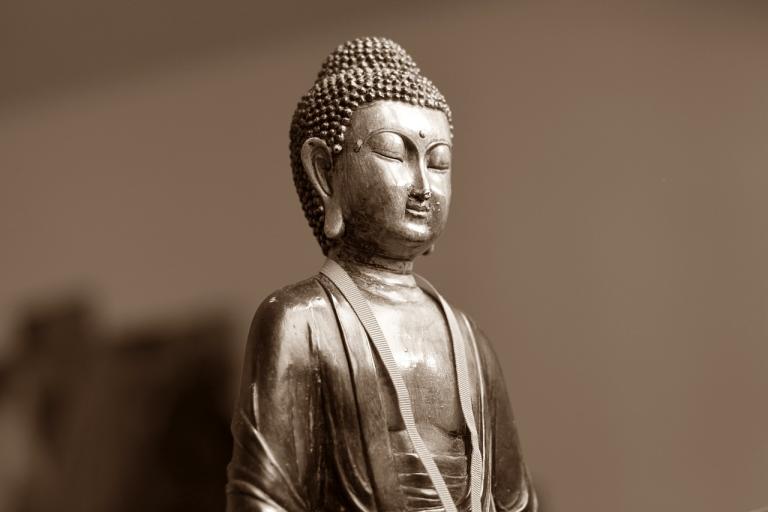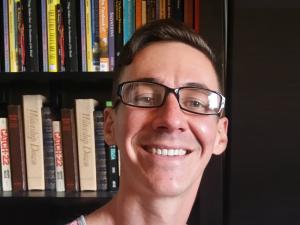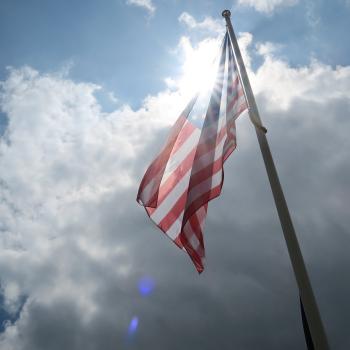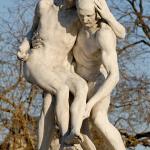
Note: This article comes from chapter 1 of the book, Sitting in the Shade of Another Tree, which is out now from Quoir Publishing and Patheos.
“There is a person whose appearance on earth is for the well-being and happiness of all. Who is that person?” This is a question from the “Anguttara Nikaya.” For Buddhists, that person is the Buddha. For Christians, that person is Jesus Christ. Through your daily life, you can help that person continue. You only need to walk in mindfulness, making peaceful, happy steps on the planet. Breathe deeply, and enjoy your breathing. Be aware that the sky is blue and the birds’ songs are beautiful. Enjoy being alive and you will help the living Christ and the living Buddha continue for a long, long time. — Thich Nhat Hanh
In Buddhism, the bodhisattva is a being, just like you and me, who makes a vow and follows through on that vow to completely be present to all beings in whatever way necessary, to be of service as long as needed. Every time we practice walking meditation, that is the practice of walking with the Lord. Every time that we sit and meditate, that is the practice of sitting in Christ in heavenly places, as the Scriptures say. — Brother Chi Sing
The year was 2014. My now best friend Michael Machuga and I were on what would become our favorite hike: Sawmill Peak. This is not your run-of-the-mill hike, mind you. You don’t start at base camp and then head up to the peak and back down again. No! You start on one side of a canyon, head down to a dam on the Feather River, take your shoes and socks off, and cross; then, after drying off, head up the other side to the top of the summit. After you take in the glorious views of the valley, you get to head back down, unclothe again, and finally, head back up the canyon to your starting point. All in all, it’s roughly five miles, but it feels more like ten. It’s steep. There are boulders to climb. The ground gives out on you from time to time. It’s Northern California, so it’s hot as hell. And did I mention that it’s steep?
What was particularly memorable about this initial hike (other than it being our first quality hangout session), is that during the trek up to the top, Michael told me that he was no longer a Christian, but a Buddhist. I wasn’t shocked, but it was still a little stunning. We had grown up in the same fundamentalist church. We had both volunteered our time, he running sound and me helping lead worship. But now, here we were, him a Buddhist and me still in the process of deconstructing my evangelicalism.
Now, don’t get me wrong, I was not quite in the Evangelical camp any longer, but I was also not entirely out of it. I still had some worry. I still had some fear, some trepidation. Would God punish the wicked and send them to hell? Were non-Christians destined to the flames, simply for not being in the “right tribe?” I didn’t think so, but I still wasn’t one-hundred percent sure. Needless to say, I was a bit worried for him. But damn! I was worried for myself, too, because I had gotten to the point where I wasn’t even sure God existed at all. And on my most skeptical of days, I was pretty convinced God didn’t.
However, to the chagrin of those who think that affirming anything other than Christianity will lead you straight to the fires of hell, what he told me about Buddhism also made perfect sense to me. Life wasn’t about what happened after we die; life was all about the “Now.” It wasn’t about “going to heaven,” or, probably more accurately, “not going to hell,” but about how to be mindful and here in this beautiful, present moment—the only moment we really have. It was about noticing the beauty around us. The singing thrushes. The smell of the pine trees and daffodils. How a summer rainstorm feels on your skin. Truly, I am so glad that I had at least deconstructed enough of my former faith to just accept what Michael was telling me that day, without any need to proselytize, without needing to try to reel him back in. This has been one of my life’s greatest blessings, because had I had an agenda that day, I would have missed out on a beautiful friendship, one that has helped me grow in ways I would have never thought imaginable.
Since that hike, Michael and I have been comrades in life. To use one of our favorite Tolkien analogies, we have been like Frodo and Sam, wandering throughout Middle-earth on some fool’s hope of an adventure. And while our shared spiritual journeys have aged us quite a bit, we also have enjoyed our time at home, at rest, back in the Shire. Only instead of kicking it in Bag End, or at the Green Dragon Inn, we like to solve the world’s problems while chillin’ on Michael’s back porch, around a crackling firepit, sipping whiskey and smoking some of the Southfarthing’s finest.
Over the years of ritualistic philosophizing, what I’ve learned from Michael is that, among other things, laziness is a virtue, but not in the way you might initially imagine. It’s not that work isn’t championed. (Hell, as of writing this article, we’ve published the entire series of The Bonfire Sessions—a ten-part anthology that spans half a decade.) It’s simply that, oftentimes, the best things in life are done by putting in less “exertion.” Alan Watts calls it “the law of reversed effort.” He writes:
When you try to stay on the surface of the water, you sink; but when you try to sink you float. When you hold your breath, you lose it—which immediately calls to mind an ancient and much neglected saying, “Whosoever would save his soul shall lose it.”
At first glance, this would repulse our American sensibilities. After all, we are a rough and tumble people. The more you work, the more you succeed. “Pick yourself up by your bootstraps,” and all that full-of-effort, individualistic shit. But have you ever worked hard enough to clear water of dirt and debris? Of course not. You clear the water of dirt and debris by leaving things alone for a minute. When you come back to the water, you’ll find that the silt has sunk to the bottom. This is also true of spiritual matters. The more you strive, the more you realize how it’s the striving that prevents you from flourishing. Sometimes it’s best to simply do “nothing.” But in doing “nothing,” we do everything. We return to breath. We become still. Pardon my overt reductionism, but to my mind, this is Buddhism in a nutshell.
MY PERSONAL FORAY INTO BUDDHISM
Buddhism, like all spiritual traditions, cannot be reduced to a set of simple instructions. It cannot be summarized in a neat and tidy list (though it does include lists like the Four Noble Truths and the Eightfold Path). Truth be told, it is far more robust than that. It is a practice, a way of being in the world. It has different schools of thought that emphasize different things. For one such instance, in the Theravada tradition, it can be argued that individual enlightenment is emphasized over corporate or communal enlightenment. This runs counter to the Mahayana tradition, which teaches that individuals (bodhisattvas) can aid each other in discovering enlightenment. In other words, as I understand things, Mahayana is more of an “other-centric “approach to the teachings of Buddha, rather than a “me-centric” approach (though again, this is entirely reductionist).
Given my love and affinity for Jesus—who emphasized self-sacrifice above all else—it is this tradition—the Mahayana tradition—that really piques my curiosity, specifically the concept of the bodhisattva. Simply put, bodhisattvas are beings who are “dedicated to the universal awakening, or enlightenment, of everyone.” But rather than being an individual person, they are archetypes. To put it this way: Anyone can be a bodhisattva because the emphasis of the bodhisattva is to live in a certain way, namely to exist as a guide, a Sherpa, a rabbi, a sage, a teacher, a mentor, and to use one’s skills to relieve the suffering of those they come into contact with. They can be world-renowned faith leaders like Thich Nhat Hanh and Martin Luther King Jr., or simple janitors, nurses, and social workers who bring food baskets to struggling neighbors in the midst of a global pandemic. They put their own needs behind the needs of others. They can be summed up in the words of Jesus, who teaches, “Whoever wishes to be great among you must be your servant, and whoever wishes to be first among you must be your slave; just as the Son of Man came not to be served but to serve, and to give his life a ransom for many” (Matt. 20:26–28).
What is so interesting about this understanding of Buddhism is that it fits within a so-called Christian worldview. In other words, one can be a Christian and practice this form of Buddhism, just like one can be a Christian and practice yoga, or meditation, or contemplative living. The two traditions—Christianity and Mahayana Buddhism—are not mutually exclusive. In fact, as Marcus Borg once said, “one might even say that becoming a bodhisattva is the goal of the fully developed Christian life.” Of course, there is a caveat: When I say “Christianity,” I’m not talking about a rigid, fundamentalist version of the faith. Instead, when I say “Christian,” I mean a robust, mystical, spiritually-driven one—the type of Christianity practiced by Fr. Richard Rohr, St. Francis of Assisi, St. Teresa of Ávila, and Brother Lawrence.
Without a doubt, there are going to be cultural and even theological differences between Christianity and Buddhism, just like there are differences between various sub-traditions inside each tradition. That is to say, both Christianity and Buddhism come from a certain context and breed certain interpretations. It’s like pointing at the moon from two locales, New York City and Shanghai, China. Two pointers will see the moon, but they will see it from different angles. Jesus, for example, lived as an impoverished Second Temple Jew, in a land occupied by arguably the world’s greatest, and perhaps most brutal, empire: Rome. He taught for a brief period of time before succumbing to a state-sponsored lynching. Gautama Buddha, on the other hand, lived in India roughly a half a millennium prior to Jesus, taught for around forty-five years, and was born into an aristocratic family. He lived roughly eighty years, whereas Jesus allegedly died at age thirty-three. He loved Bodhi trees, whereas Jesus wasn’t a fan of figs. Again, though, they both pointed at the moon from their own vantage point, and would probably agree more than disagree (though, it is likely they would disagree on some matters).
THE WAY OF CHRIST, THE WAY OF THE BODHISATTVA
I know that what I have been saying thus far will cause many Christians to bristle. For most, it’s the Jesus Way or the highway (to hell). And that’s okay. Spiritually, folks are where they are, and rushing the process never helps things. As Michael has said to me before, “No one is foolish enough to think [… ] that pulling on a corn stalk to make it grow faster will do any good.” As an avid and, might I say, accomplished gardener, truer words have never been spoken. Things grow at their own pace, and while we can tend the soil, we can’t force blooming and blossoming. So, I can respect such bristling. But if you could, please hear me out because it could be that you’ll actually learn something here (like I have from Michael).
When Jesus said “I am the way,” I don’t believe he meant that knowing about him was the way to heaven. Put another way, Jesus wasn’t telling us that there is only one individual named “Christ,” but instead that Christ was more of a way of becoming your true self. What he was talking about was a way of being in the world that all of us could tap into—the “I” isn’t specific to Jesus; the “I” is a word we can all use. Yes, he understood his Christ nature (perhaps he was even the first to do so). But no, he wasn’t the only one to whom this ability was given. It was open to all people, just as the Mahayana tradition teaches about the bodhisattva. To put it as succinctly as possible: The way of the bodhisattva, as well as the way of Christ, is the way of living as a true human. Marcus Borg uses the following story about a Hindu professor in Christian seminary to drive this point home. Quoting the professor, he writes:
“This verse [John 14:6] is absolutely true—Jesus is the only way,” said the Hindu professor. Then he continued, “And that way—of dying to an old way of being and being born into a new way of being—is known in all the religions of the world.” The “way” of Jesus is a universal way, known even to millions who have never heard of Jesus.
In the first few centuries after Jesus’ life, death, and resurrection, people who followed him were known as people of “the Way.” They were people who lived life in such a way that it matched, for all intents and purposes, the life and teachings of Jesus of Nazareth. The teachings from the Sermon on the Mount and The Didache were lynchpins of this Way. They were not, however, static teachings, like many of those found in today’s churches. They were practical. They were behaviors we could practice in our daily lives. (As a note: they were so practical that even Gandhi, a Hindu, read the Sermon on the Mount twice daily, and applied its teachings to his very real life.)
If I could wrap up the way the early Christians approached their tradition in one word, it would be this: kenosis. In Greek, the word kenosis is derived from the verb kenoo and literally means “the act of emptying.” In Christian theology, however, kenosis is much more specific and is typically used in reference to Jesus emptying his own will so that he could act in accordance to the divine will. This understanding comes from a number of places in the Bible, but the most direct passage is found in Philippians 2:5–8, and it reads:
Let the same mind be in you that was in Christ Jesus, who, though he was in the form of God, did not regard equality with God as something to be exploited, but emptied himself, taking the form of a slave, being born in human likeness. And being found in human form, he humbled himself and became obedient to the point of death—even death on a cross.
The beautiful thing about this kenotic ethic of love, so to speak—this understanding that to become “one” is to be willing to go to the cross for the other—is that true liberty is discovered. At first glance, this seems paradoxical, for how can one be free while living humbly and obedient to another? Put simply: That is just the way in which we are designed. Theologian Thomas Jay Oord explains it like this:
Kenosis as self-giving, others-empowering love also supports healthy self-love. Self-giving love only sometimes involves self-sacrifice. Some Christians have unfortunately believed that self-giving love opposes acting for one’s own well-being. By contrast, kenosis as self-giving love supports the truth that self-love has a legitimate place in Christian ethics. Love decenters self-interest, but it does not destroy it.
The Buddhists understand this. As the Mahayana tradition rightly acknowledges, we are not simply separate and distinct beings, but interbeings. And more than that! Our joy and peace and wellbeing are dependent upon the joy and peace and wellbeing of others. As Thich Nhat Hanh reminds us, “In true love, happiness is not an individual matter. If the other person is not happy, it will be impossible for us to be happy ourselves.”
As recognized interbeings, then, it makes sense that in the Mahayana tradition, the bodhisattva is so highly revered and needed. For what good is personal enlightenment if those around us—those we love dearly—are joyless, not at peace, and full of strife and suffering? In the same way, what good is the way of Jesus if it is not a way of reaching out to all sentient beings, with compassion flowing through our hearts, for the sake of aiding them in their personal growth toward recognized Christlikeness or Buddhahood?
Again, I put things in so many terms, not to offend those of you who are determined to grasp a Jesus who is the only way to God, but to suggest that Jesus wants us all to realize that there is a door to God, and a way to enter, and that all are capable of entering. Jesus is but an archetype. He is but a model for us to follow. So, too, are all bodhisattvas. If it is a person’s mission is to alleviate suffering in the lives they touch, then they are a part of this Way! Dr. Martin Luther King Jr. was one. Gandhi was one. Michael Machuga is one. My dear friend Michelle Collins is one. None claim to be perfect. None claim to be the embodiment of what it means to follow either Christ or the Buddha. But they are all guides. They are all other-oriented. They are all living out of their true, kenotic self for the sake of those they come into contact with on this adventure through our very own Middle-earth.
IN CLOSING
Much, much more could be said about the relation between Jesus Christ and the bodhisattva. The point being is that both embody a path we can all take in life. It’s a path imbued with generosity, patience, kindness, compassion, grace, mercy, and above all else, love. And all of it is done for the benefit of those around us.
However, this is not a path that should be taken lightly. Though it is the Path, it is not an easy path. Like the idea of bodhicitta—the mind of enlightenment—it is always present but needs cultivation, requiring diligent focus and practice. Pema Chӧdrӧn offers a fantastic example in the following:
Those who train wholeheartedly in awakening unconditional and relative bodhicitta are called bodhisattvas or warriors—not warriors who kill and harm but warriors of nonaggression who hear the cries of the world. These are men and women who are willing to train in the middle of the fire. Training in the middle of the fire can mean that warrior-bodhisattvas enter challenging situations in order to alleviate suffering. It also refers to their willingness to cut through personal reactivity and self-deception, to their dedication to uncovering the basic distorted energy of bodhicitta. We have many examples of master warriors—people like Mother Teresa and Martin Luther King—who recognize that the greatest harm comes from our own aggressive minds. They devoted their lives to helping others understand this truth. There are also many ordinary people who spend their lives training in opening their hearts and minds in order to help others do the same. Like them, we could learn to relate to ourselves and our world as warriors. We could train in awakening our courage and love.
All this is why, in the first couple centuries after Jesus, Christian converts didn’t simply pray a magic prayer after their pastor called them to the altar, but rather, “tried the faith on” for three to five years in order to see if they could do it. Because eternal hellfire wasn’t the motivating factor like it is today, decisions weren’t made so rashly. People had to weigh out their options because of how difficult following the Christ way was. As Jesus taught, “Enter through the narrow gate; for the gate is wide and the road is easy that leads to destruction, and there are many who take it. For the gate is narrow and the road is hard that leads to life, and there are few who find it” (Matt. 7:13–14).
It is worth it, though. Like I said earlier, walking this path—this Way—is how one achieves true freedom. Not just freedom for ourselves, but, more importantly, freedom for the ones we love. Indeed, it is freedom for all humanity, should enough take up this calling to heal the world of all suffering.
As we close this chapter, I’ll leave you with a prayer from Shantideva, an Indian Buddhist sage who lived around the year 700 C.E. May it help you connect to the living Buddha and living Christ that resides in all of us.
May I be a guard for those who need protection,
a guide for those on the path,
a boat, a raft, a bridge for those who wish to cross the flood.
May I be a lamp in the darkness,
a resting place for the weary,
a healing medicine for all who are sick,
a vase of plenty, a tree of miracles.
And for the boundless multitudes of living beings,
may I bring sustenance and awakening,
enduring like the earth and sky
until all beings are freed from sorrow
and all are awakened.
Also, if you’ve been digging my work on here, and want to see me be able to continue writing as close to full-time as humanly possible, please take a look at my Patreon page at www.patreon.com/mjdistefano. Even $1 a month helps bigly!


















